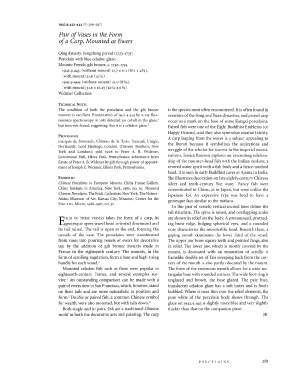Page 277 - Decorative Arts, Part II: Far Eastern Ceramics and Paintings, Persian and Indian Rugs and Carpets
P. 277
1942.9-443-444 (C-296-297)
Pair of Vases in the Form
of a Carp, Mounted as Ewers
Qing dynasty, Yongzheng period (1723-1735)
Porcelain with blue celadon glaze;
Mounts: French, gilt bronze, c. 1730-1755,
3
1942.9.443: (without mount) 21.7 x 11.1 (8V2 x 4 /s),
(with mount) 31.6 (12 %6)
3
1942.9.444: (without mount) 21.0 (8 /i6),
(with mount) 31.6 x 16.25 (i2%> x 6%)
Widener Collection
TECHNICAL NOTES
The condition of both the porcelains and the gilt bronze is the species most often encountered. It is often found in
mounts is excellent. Examination of 1942.9.443 by x-ray fluo- ceramics of the Song and Yuan dynasties, and paired carp
rescence spectroscopy in 1985 detected no cobalt in the glaze, 1 occur as a mark on the base of some Kangxi porcelains.
but iron was found, suggesting that it is a celadon glaze. 2 Paired fish were one of the Eight Buddhist Emblems (or
Happy Omens), and they also symbolize marital fidelity.
PROVENANCE A carp leaping from the waves is a subject appealing to
marquis de Montault, Chateau de la Terte, Trescuel, L'Aigle,
Normandy. Lord Hastings, London. (Duveen Brothers, New the literati because it symbolizes the aspirations and
York and London); sold 1908 to Peter A. B. Widener, struggle of the scholar for success in the imperial exami-
Lynnewood Hall, Elkins Park, Pennsylvania; inheritance from nations. Jessica Rawson explores an interesting relation-
Estate of Peter A. B. Widener by gift through power of appoint- ship of the monster-head fish with the Indian makara, a
ment of Joseph E. Widener, Elkins Park, Pennsylvania. revered water spirit with a fish body and a fierce-toothed
head. It is seen in early Buddhist caves at Ajanta in India.
EXHIBITED She illustrates decoration on late eighth-century Chinese
Chinese Porcelains in European Mounts, China House Gallery, silver and tenth-century Yue ware. 7 Fancy fish were
China Institute in America, New York, 1980, no. 30. Mounted domesticated in China, as in Japan, but were unlike the
Chinese Porcelains, The Frick Collection, New York; The Nelson- Japanese koi. An expensive type was bred to have a
Atkins Museum of Art, Kansas City, Missouri; Center for the grotesque face similar to the makara.
Fine Arts, Miami, 1986-1987, no. 32.
In this pair of vessels, vertical incised lines define the
tail structure. The spine is raised, and overlapping scales
ACH OF THESE VESSELS takes the form of a carp, its are shown in relief on the body. A pronounced, protrud-
Egrotesque open-jawed head oriented downward and ing brow ridge, bulging spherical eyes, and a rounded
its tail raised. The tail is open at the end, forming the nose characterize the monsterlike head. Beneath these, a
mouth of the vase. The porcelains were transformed gaping mouth dominates the lower third of the vessel.
from vases into pouring vessels or ewers for decorative The upper jaw bears square teeth and pointed fangs, also
use by the addition of gilt bronze mounts made in in relief. The lower jaw, which is mostly covered by the
France in the eighteenth century. The mounts, in the mount, is decorated with an emanation of scrolls. A
form of scrolling vegetation, form a base and high-rising flamelike double set of fins sweeping back from the cor-
handle for each vessel. 3 ners of the mouth is also partly obscured by the mount.
Mounted celadon fish such as these were popular in The form of the enormous mouth allows for a wide rec-
eighteenth-century France, and several examples sur- tangular base with rounded corners. The wide foot-ring is
4
vive. An outstanding comparison can be made with a unglazed and brown, the base glazed. The pale blue,
pair of ewers now in San Francisco, which, however, stand translucent celadon glaze has a soft luster and is finely
on their tails and are more naturalistic in position and bubbled. Where it runs thin over the relief elements, the
5
form. Double or paired fish, a common Chinese symbol pure white of the porcelain body shows through. The
for wealth, were also mounted, but with tails down. 6 glaze on 1942.9.443 is slightly more blue and very slightly
Both singly and in pairs, fish are a traditional Chinese thicker than that on the companion piece.
motif in both the decorative arts and painting. The carp JK
P O R C E L A I N S 261

